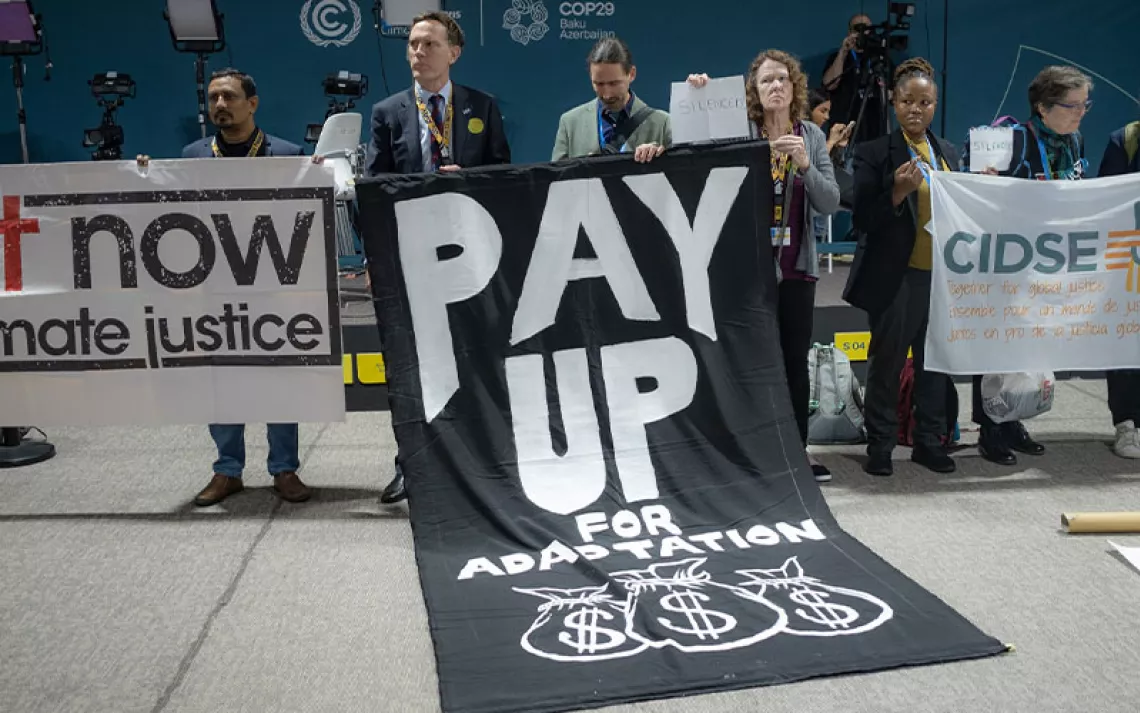Can the Defense Production Act Jump-Start a Transition to Renewable Energy?
Climate activists are calling for a full-scale mobilization

Heat pump. | Photo by iStock/dpproductions
Update: June 6, 2022
Clean energy advocates and climate activists are pumped.
On June 6, President Biden invoked the Domestic Production Act (DPA) to accelerate the domestic production of five key energy technologies: solar panel parts; transformers and other grid components; heat pumps; building insulation; and the equipment needed to produce clean hydrogen fuel. In tandem, the administration is suspending the tariffs on solar panels that have stalled solar installations here in the United States.
In a press release, the White House promised to “strongly encourage” projects that help spur the clean energy transition in low-income communities historically overburdened by legacy pollution.
Jean Su, senior attorney for the Center for Biological Diversity, wrote on Twitter that Biden’s plan is “impressive” and went onto say that it “encourages strong labor standards & the convening of industry, labor, & environmental justice stakeholders to map out the just energy system we need.”
With the move, Biden bypasses a gridlocked Congress that has been unable to advance an ambitious climate agenda.
Keep going, advocates urged.
“Technologies like heat pumps are absolutely critical to efforts of local SAFE Cities working to move off fossil fuels,” said Nathan Taft, Stand.earth’s senior digital campaigner. “We hope that Biden will continue using the full powers of his office to address the climate crisis and environmental injustice with the scale and urgency that’s required.”
*
On February 27, just days after Russia invaded Ukraine, Bill McKibben published a new essay on Substack in which he proposed a radically simple idea: President Joe Biden should invoke the Defense Production Act to undermine Russia’s economic power over the European Union. US manufacturers would get to work producing millions of electric heat pumps. The units could then be shipped to Europe and installed en masse before the next heating season—just in time to “dramatically lessen Putin’s power.”
Russia’s unjust war has pointed a stark spotlight on Europe’s dependence on Russian fossil fuels, which in turn has prevented the bloc from imposing meaningful sanctions. About 40 percent of methane gas consumed in the EU is imported from Russia, and many NATO countries get most of their gas from Russia.
“Fossil fuels aren’t just poisoning our communities and heating our climate; they’re empowering autocrats and letting them get away with horrible stuff,” says Nathan Taft, senior digital campaigner at Stand.Earth.
Replacing gas furnaces with efficient electric heat pumps could take a significant bite out of energy demand, even if the electricity comes from power plants fueled by methane gas. American manufacturing would also catalyze the adoption of heat pumps here at home.
Progressive groups jumped on the idea. Taft reached out to key members of Build Back Fossil Free, a coalition of hundreds of organizations concerned with environmental and economic justice, and in less than a week, the groups drafted a letter to Biden urging him to invoke the Defense Production Act to “ramp up the deployment of renewable energy to transition the world off fossil fuels and generate millions of good quality, union jobs.” Over 200 organizations signed on. Progressives in the House and Senate have since sent their own letters.
Will Biden seize the opportunity to jump-start the transition to clean energy, or will the idea die on the vine?
What the heck is the Defense Production Act?
During World War II, Congress passed two War Powers Acts, granting the executive branch broad emergency powers. President Roosevelt used the War Powers Acts to pump out ships, planes, and bombs. The Defense Production Act, signed in 1950, was modeled after these earlier pieces of legislation. Its primary purpose is to expedite and expand the supply of materials and services needed to promote the national defense. President Harry Truman used the act to spur US steel and aluminum manufacturing during the Korean War, but over the years, Congress has broadened the definition of “national defense.” FEMA uses the act during federally declared natural disasters. President Trump used it to order the mass production of ventilators, and Biden has used it twice to crank out high-quality N95 masks and 4,000 miles of fire hose, which were deployed to wildfires in California.
Biden is well within his rights to use the Defense Production Act to combat the climate emergency, progressives argue. They see the act as part of a suite of executive tools Biden could and should use to circumvent congressional roadblocks.
“We wanted to make clear this is something that could help with the global transition, not just EU,” says Taft. “There’s a lot more Biden could be doing without needing approval from Joe Manchin.”
Why heat pumps?
Electric heat pumps are extremely efficient. Rather than burning fuel directly, as a gas furnace does, they work by harvesting heat from the air or ground and transferring it into or out of a room. They can also be used for both space heating and cooling. According to the EPA, properly installed air-source heat pumps can deliver up to three times more heat energy than the electrical energy they consume. Electric heat pumps are also better for your health than so-called combustion appliances, as they don’t emit carbon monoxide or other noxious gases.
Heat pumps are widely used in Europe already, but switching out gas furnaces to electric heat pumps on a broader scale could help the EU meet its decarbonization goals. According to a coalition of industry leaders, the EU could handle 50 million heat pumps without destabilizing the electric grid and thereby reduce heating-related carbon emissions by 60 percent.
We could use them here too. About half of all homes in the United States are currently heated with gas-burning appliances. According to a new study published in the April issue of Energy Technology, which compares the climate impact of residential heat pumps with gas furnaces, heat pumps could reduce carbon dioxide emissions by 38 to 53 percent. The study takes into account direct emissions from the gas furnaces, emissions from the generation of electricity, and “fugitive” emissions from leaky appliances.
OK, heat pumps. But could Biden do even more?
Absolutely. Advocates who have jumped on McKibben’s idea don’t want to stop at heat pumps. In fact, frustrated progressives have been pushing Biden to use his emergency powers to turbo-charge the country’s clean energy transition ever since he took office, especially since the Build Back Better Act stalled in the Senate.
Biden has approached climate through the lens of a senator, says Jean Su, director of the Energy Justice Program for the Center for Biological Diversity. “Understanding that he’s being stonewalled in Congress, he can overcome that by using his presidential powers that are fully legal to combat the climate emergency.”
Build Back Fossil Free has outlined 25 executive actions Biden could take to deliver on his climate promises. (He has already accomplished a few of them.) On February 23, the day before Russia invaded Ukraine, the Center for Biological Diversity published a 55-page road map outlining how Biden could use his emergency powers to accelerate the transition to a clean energy economy.
Pressure is building. On March 17, as part of a broader executive action agenda, the Progressive Congressional Caucus urged Biden to declare a national climate emergency and invoke authorities under the Defense Production Act and Trade Expansion Act to manufacture affordable renewable energy technologies.
And on March 23, five senators, led by Ed Markey (D-MA), sent Biden a letter urging him to “examine all possible routes to support and deploy clean energy and energy-efficient electric technologies as part of our near-term domestic and international response to the economic upheaval caused by Russia’s war on Ukraine.”
Wait, didn’t Biden also just call for more methane gas exports?
Yes. On March 25, Biden announced that the US has committed to providing the EU with an additional 15 billion cubic meters of US liquefied natural gas (LNG) this year. In addition, the US and European Commission agreed to expand US imports to 50 billion cubic meters by 2030.
As critics point out, the US is unlikely to deliver on that promise in the short term; the infrastructure simply isn’t in place.
“It takes years to build export terminals, not to mention you’re locking in that [fossil fuel] infrastructure,” says Taft. “But as Bill [McKibben] noted in his piece, we could deliver a significant number of heat pumps before next winter and make a big dent.”
Naturally, methane gas advocates are ecstatic, especially Manchin, who has been urging Biden to use the Defense Production Act to complete stalled pipelines. Manchin and GOP senators have been calling for more drilling, more pipelines, and more LNG terminals to boost energy security. But energy security doesn’t mean producing more fossil fuels at home, says Su. “It actually means getting off fossil fuels entirely and building up the renewable energy [infrastructure] that is immune to the global volatility that we see with fossil fuels.”
So will Biden invoke the Defense Production Act?
He already has. On March 31, the White House announced a two-pronged strategy for fighting high gasoline prices, which they’re blaming on the Russian invasion (“Putin’s Price Hike”). First, boost supply by ramping up domestic production and unlocking the Strategic Petroleum Reserve; second, achieve “real American energy independence” by reducing dependence on oil. As part of this pledge, Biden plans to invoke the Defense Production Act to bolster domestic mining and processing of key minerals needed for energy storage batteries. (This seemingly is partly in response to a letter penned by four senators, including Manchin.) Though this may signal Biden is willing to use the act to spur parts of his climate agenda, Su cautions that any actions he takes must keep environmental justice and equity front and center, especially when it comes to extractive processes.
“We can’t repeat the violence that was historically done with mining,” says Su. “We hope that the Biden administration uses the DPA for what we’re most bullish about, which is manufacturing for renewable energy.”
The White House fact sheet notes that Biden is “reviewing further potential uses of DPA … to secure safer, cleaner, more resilient energy,” and it also promises that Biden will “call on Congress” to pass his climate agenda. To that end, a broad coalition is planning a rally in front of the White House on April 23 to crank up the pressure.
Long before the war in Ukraine, climate action leaders were calling on lawmakers to treat climate change like the emergency that it is. In 2016, McKibben wrote an urgent essay for The New Republic, in which he characterized climate disruption as an enemy seizing territory (Arctic ice melt), attacking cities with firestorms (California wildfires), and deploying biological weapons (the Zika virus). McKibben hoped to spark a wartime response akin to the incredible mobilization during World War II when American factories converted their operations overnight and started pumping out helmets, ships, tanks, and planes on a dizzying scale.
Now that we have an actual war in parallel with the climate crisis, will we finally take the steps we need to take to avoid global climate catastrophe?
 The Magazine of The Sierra Club
The Magazine of The Sierra Club



